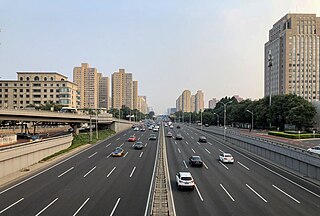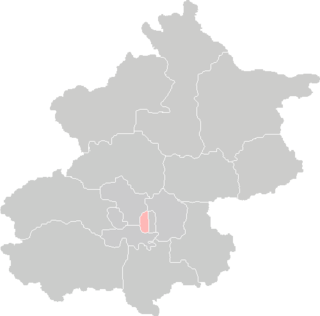
The 2nd Ring Road is the innermost ring road highway which encircles the city center of Beijing, People's Republic of China.

The Dongcheng District of Beijing covers the eastern half of Beijing's urban core, including all of the eastern half of the Old City inside of the 2nd Ring Road with the northernmost extent crossing into the area within the 3rd Ring Road. Its 40.6 km2 (15.7 sq mi) area is further subdivided into 17 subdistricts.

Xicheng District is a district of Beijing. Its 32 square kilometers (12 sq mi) cover the western half of the old city, and has 706,691 inhabitants. Its postal code is 100032. Xicheng is subdivided into 15 subdistricts of the city proper of Beijing. The former Xuanwu District was merged into Xicheng in July 2010.

Chaoyangmen was a gate in the former city wall of Beijing. It is now a transportation node and a district border in Beijing. It is located in the Dongcheng District of northeastern central Beijing. Running from north to south is the eastern 2nd Ring Road. The Beijing Subway has a stop at Chaoyangmen.

Jianguomen Outer Street, also transliterated as Jianguomen Wai Avenue is a major street in urban Beijing. It forms part of the extended Chang'an Avenue.

Jianguomen Inner Street is a major street in urban Beijing. It forms part of the extended Chang'an Avenue.

East Chang'an Avenue is a major road in Beijing, China. It forms part of the extended Chang'an Avenue.

West Chang'an Avenue is a major avenue in urban Beijing. It forms part of the extended Chang'an Avenue.

Fuxingmen Inner Street is a major street in urban Beijing. It forms part of the extended Chang'an Avenue.

Fuxingmen Outer Street is a major street in urban Beijing. It forms part of the extended Chang'an Avenue.

Line 1 of the Beijing Subway is the oldest and one of the busiest lines of Beijing's mass transit rail network. Line 1 runs underneath Chang'an Avenue, the city's grand east–west thoroughfare, right through the heart of Beijing with stops on either side of Tiananmen Square. Line 1's color is dark red. Through operation with the Batong line started on August 29, 2021.

Line 2 of the Beijing Subway is a rapid transit rail line in central Beijing that runs in a rectangular loop around the city centre. The line traces the Ming dynasty inner city wall, which was demolished and paved over by the 2nd Ring Road and Qianmen Avenue to make room. Line 2, opened in 1984, is the second oldest and one of the busiest of Beijing's subway lines, and to date only one to serve Beijing railway station. All 18 stations on the 23.1 km (14.4 mi) line are underground. 12 of the 18 stations offer transfers to other lines. Line 2's color is dark blue.

Dongdan, literally "Eastern Single" or "Eastern Single Sign Gate" is the name of a crossing on Beijing's Chang'an Avenue and surrounding neighborhood. The name is derived from the single paifang or Chinese sign gate that once marked the intersection. In the checkerboard layout of Beijing, the Dongdan intersection in Dongcheng District to the east of the city centre, is balanced by Xidan or the "Western Single" in Xicheng District to the west of city centre. Dongdan and Xidan were traditionally market centers.

The Beijing city fortifications were series of walls with towers and gates constructed in the city of Beijing, China in the early 1400s until they were partially demolished in 1965 for the construction of the 2nd Ring Road and Line 2 of the Beijing Subway. The original walls were preserved in the southeastern part of the city, just south of the Beijing railway station. The entire perimeter of the Inner and Outer city walls stretched for approximately 60 kilometres (37 mi).
Chang'an was the capital of several Chinese dynasties, located on the site of present-day Xi'an, Shaanxi.

Di'anmen previously Bei'anmen was an imperial gate in Beijing, China. The gate was first built in the Yongle period of the Ming dynasty, and served as the main northern gate to the Imperial City. The gate is located north of Jingshan Park and south of the Drum Tower. The gate was demolished in 1954. Efforts to restore it have been under way since 2013.

West Chang'an Avenue Subdistrict is a subdistrict on the eastern part of Xicheng District, Beijing.
Beijing has many neighborhoods, some of which are new and others with a long history.





















